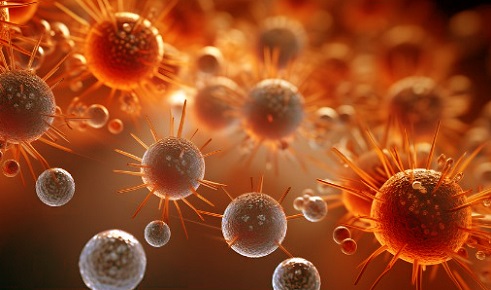Nikhil Prasad Fact checked by:Thailand Medical News Team Nov 29, 2024 4 months, 2 weeks, 55 minutes ago
Medical News: A groundbreaking study involving scientists from the University of Virginia Health System-USA, University of Dundee-UK, and University of Manchester-UK has brought to light the significant role of the IL-33/ST2 signaling axis in the pathogenesis of COVID-19. Their findings covered in this
Medical News report, offer a deeper understanding of how immune responses, specifically type 2 immunity, contribute to disease severity in patients infected with SARS-CoV-2.
 Role of IL-33/ST2 Signaling Axis in COVID-19 Pathogenesis
Role of IL-33/ST2 Signaling Axis in COVID-19 Pathogenesis
The IL-33/ST2 signaling axis, a well-documented pathway in immune regulation, is now recognized as a potential driver of severe COVID-19 outcomes. By targeting this pathway, researchers have uncovered promising avenues for therapeutic intervention, especially for those suffering from acute disease complications such as pneumonia, acute respiratory distress syndrome (ARDS), and multi-organ failure.
Understanding the IL-33/ST2 Signaling Axis
The IL-33/ST2 signaling axis plays a crucial role in modulating type 2 immune responses. IL-33, a cytokine released from damaged cells, binds to the ST2 receptor on immune cells, activating pathways that typically help repair tissue damage and control infections. However, in the context of COVID-19, this pathway appears to exacerbate immune system overactivity, leading to damaging inflammation in the lungs and other tissues.
Elevated levels of IL-33 have been observed in COVID-19 patients, particularly those with severe disease, where it is associated with poor outcomes. Researchers hypothesize that this heightened activity enhances the production of type 2 cytokines like IL-5, which contribute to lung inflammation and worsen the clinical course of the disease.
Methodology and Approach
To investigate the role of the IL-33/ST2 axis in COVID-19, researchers used a mouse model infected with SARS-CoV-2 MA10, a variant adapted to efficiently replicate in mice. They employed both genetic and pharmacologic approaches to inhibit IL-33/ST2 signaling, providing a comprehensive analysis of its impact on disease outcomes.
In the genetic arm of the study, researchers used mice lacking the ST2 receptor (ST2-/- mice). These mice were compared to their wild-type counterparts, which possess a functioning IL-33/ST2 pathway. The pharmacologic approach involved treating normal mice with HpBARI_Hom2, a protein derived from helminths that binds to the ST2 receptor and blocks IL-33 signaling. This protein was administered intranasally and intraperitoneally at key time points before and after infection.
Key Findings
-Improved Survival and Weight Loss:
The results demonstrated a clear protective effect of IL-33/ST2 inhibition. ST2-/- mice showed significantly higher survival rates (69.2%) compared to wild-type controls (13.3%) following SARS-CoV-2 infection. They also experienced less severe weight loss, a critical indicator of disease severity in animal models.
Si
milarly, HpBARI_Hom2-treated mice exhibited a survival rate of 60%, compared to only 10% in untreated controls. This pharmacologic intervention also reduced weight loss and clinical signs of distress, reinforcing the benefits of blocking the IL-33/ST2 axis.
-No Reduction in Viral Load:
Interestingly, despite these improvements, the interventions did not reduce the viral load in the lungs. This finding underscores that the IL-33/ST2 axis primarily drives immunopathology rather than influencing the virus's ability to replicate. It highlights the importance of focusing on immune modulation in treating severe COVID-19.
-Impact on Cytokine Environment:
Further analysis of lung tissues and bronchoalveolar lavage fluid revealed changes in the cytokine environment. HpBARI_Hom2-treated mice had significantly lower levels of IL-5, a cytokine known to enhance type 2 immune responses and contribute to lung inflammation. The reduction in IL-5 aligns with the proposed mechanism through which IL-33/ST2 signaling exacerbates disease. However, levels of other type 2 cytokines like IL-4 and IL-13 remained unchanged, suggesting a selective influence of this pathway.
Broader Implications of the Study
The findings underscore the potential of targeting the IL-33/ST2 axis to mitigate severe COVID-19 symptoms. Elevated IL-33 levels in human patients have already been linked to poor clinical outcomes, and this study provides mechanistic insights into how this cytokine drives immunopathology.
The fact that IL-33/ST2 inhibition improved survival without affecting viral load is particularly significant. It supports the idea that immune system overactivation, rather than direct viral damage, is the primary cause of severe COVID-19. This concept is consistent with other studies that have identified type 2 cytokines, such as IL-13, as drivers of disease severity.
Potential Therapeutic Applications
The pharmacologic blockade of the IL-33/ST2 axis using HpBARI_Hom2 highlights a novel therapeutic strategy. Unlike traditional antiviral drugs, which aim to reduce viral replication, this approach focuses on modulating the immune response to prevent tissue damage. This distinction is crucial in diseases like COVID-19, where hyperinflammation often causes more harm than the virus itself.
Future studies could explore combining IL-33/ST2 inhibitors with existing therapies, such as corticosteroids or IL-6 inhibitors, to maximize benefits. Additionally, clinical trials testing the safety and efficacy of IL-33 neutralizing antibodies in COVID-19 patients would provide valuable insights into the potential of this approach.
Conclusions
This study offers compelling evidence that the IL-33/ST2 signaling axis plays a pivotal role in the pathogenesis of severe COVID-19. By driving type 2 immune responses, this pathway contributes to lung inflammation and poor clinical outcomes. The protective effects observed in both genetic and pharmacologic models emphasize the therapeutic potential of targeting IL-33/ST2 signaling.
These findings have broader implications beyond COVID-19. The IL-33/ST2 axis may also play a role in other diseases characterized by immune system overactivity, such as asthma and autoimmune disorders. By unraveling the complexities of this signaling pathway, researchers are paving the way for innovative treatments that address the root causes of immune-driven diseases.
The study findings were published on a preprint server and are currently being peer reviewed.
https://www.biorxiv.org/content/10.1101/2024.11.27.625579v1
For the latest COVID-19 News, keep on logging to Thailand
Medical News.
Read Also:
https://www.thailandmedical.news/news/french-study-claims-that-sars-cov-2-adapts-to-human-cells-by-hijacking-rna-processes
https://www.thailandmedical.news/news/coronavirus-s-protein-alters-dsrna-accumulation-and-stress-granule-formation-by-regulating-adari1
https://www.thailandmedical.news/articles/coronavirus
